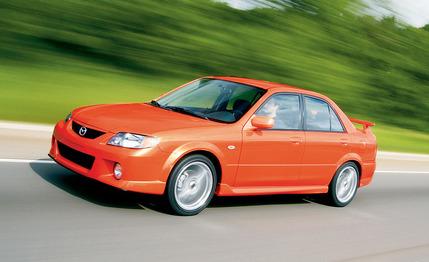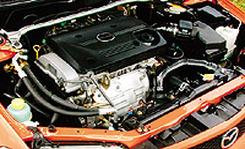 Road Test
Road Test
It's no secret that Mazda wants to be perceived as a purveyor of vehicles that stimulate the driver gratification glands a little more than competing products. That's what the zoom-zoom ad campaign is all about.
It's equally clear the Miata can't sustain this image building all by itself. If zoom-zoom is going to have credibility, some of the other Mazdas gotta get some zoom, too. That's this car's mission. It's conceived to demonstrate Mazda's commitment to fun-to-drive, and also to help establish a new performance subsidiary that will sell stuff to young owners who want their cars to stand out from the herd. It's called Mazdaspeed, and if it turns out to be a profit center, à la Toyota Racing Development, well, so much the better.
Given the foregoing, Mazda could have no more logical starting point than the Protegé, an entry-level compact sedan that also happens to be among the best in its class. In our most recent econobox comparison test ("Little Cars 6.1," June 2000), a Protegé ES took home the Oscar and has since been updated: more refinement, better handling, more power.
However, the truth is we've seen this hot-rod-Protegé movie before, albeit at slower speed. A little over a year ago, Mazda took its first cut at this project, enlisting the services of Racing Beat, the longtime Mazda tuning shop, to handle suspension development. The result was the MP3, a brilliant blend of supple ride and athletic handling that emerged as the winner of a five-car hot-compact free-for-all ("Budget Banditos," November 2001). And it prevailed despite a serious shortage of horsepower. We compared it to "an aspiring welterweight fighter with all the moves but no punch."
So here's the sequel, and this time the kid packs knockout power. Although the cast of characters is essentially the same -- Mazda, Racing Beat, RacingHart, and Kenwood -- there's one new player on the team this time around. Callaway Cars, making its debut deal with an Asian manufacturer, was tapped to add turbocharging to the Protegé's powertrain.

Callaway adapted a Garrett T25 ball-bearing turbo with an integral waste gate for the project, developing a unique turbine housing for this application. To keep costs down, Callaway sorted through the Mazda parts bin and borrowed an air-to-air intercooler employed in a European turbo-diesel Protegé, as well as a higher-capacity radiator. A revised Visteon engine-management program increases fuel flow. By limiting boost to a maximum of 6.9 psi, Callaway and Mazda were able to avoid making changes to the engine's internals, although a new catalytic converter was required.
The net gain of all the foregoing: 170 horsepower (versus 140 for the MP3, 130 for the base version of the 2.0-liter DOHC 16-valve four) and 155 pound-feet of torque (versus the MP3's 142, 135 base).
Harnessing a power boost of this magnitude required upgrades to the drivetrain and suspension. The five-speed manual transmission is unchanged, but Mazda installed heavier (24 millimeters versus 22mm stock) half-shafts and a Tochigi Fuji Sangyo KK Super limited-slip differential to send uniform thrust to both front wheels. The latter are 7.0-by-17-inch aluminum alloys from RacingHart, wearing Z-rated 215/45 Bridgestone Potenza RE040 tires.